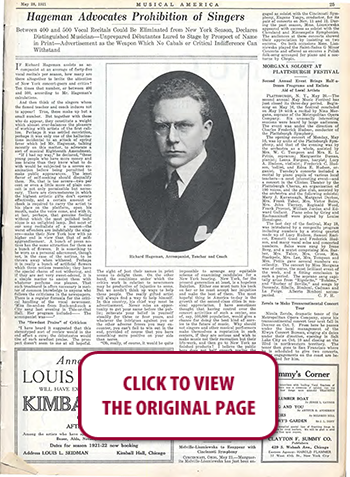 100 YEARS AGO IN MUSICAL AMERICA (394)
100 YEARS AGO IN MUSICAL AMERICA (394)
May 28, 1921
Page 25
Hageman Advocates Prohibition of Singers
Between 400 and 500 Vocal Recitals Could Be Eliminated from New York Season, Declares Distinguished Musician—Unprepared Debutantes Lured to Stage by Prospect of Name in Print—Advertisement as the Weapon Which No Cabals or Critical Indifference Can Withstand
IF Richard Hageman assists as accompanist at an average of forty-five vocal recitals per season, how many are there altogether to invite the attention of New York concert-goers and critics? Ten times that number, or between 400 and 500, according to Mr. Hageman’s calculations.
And then think of the singers whom the famed teacher and coach induces not to appear! True, these make up but a small number. But together with those who do appear, they constitute a weight which almost over-balances the pleasure of working with artists of the first calibre. Perhaps it was settled conviction, perhaps it was only one of the hallucinations incidental to an attack of spring fever which led Mr. Hageman, talking recently on this matter, to advocate a sort of musical Eighteenth Amendment.
“If I had my way,” he declared, “these young people who have more money and less brains than they know what to do with would be subjected to a severe examination before being permitted to make public appearances. The least flavor of self-seeking should disqualify them. No, that is too severe—two per cent or even a little more of plain conceit is not only permissible but necessary. There are circumstances in which the highest artistic gifts don’t operate effectively, and a certain amount of cheek is required to carry the artist to his place on the platform, open his mouth, make the voice come, and with it, at last, perhaps, that genuine feeling without which the most polished technique is an unlighted lamp. But most of our song recitalists of a season—the worst offenders are indubitably the singers—make their New York bow with no higher end in view than that of self-aggrandizement. A bunch of press notices has the same attraction for them as a bunch of flowers. It is something to be worn as a personal adornment, though not, in the case of the notices, to be thrown away when withered. Perhaps it is really a bunch of artificial flowers which these notices resemble; they have the special charm of not withering, and if they are not very sweet-odored, it is a simple matter to anoint them with whatever perfume one pleases. That such treatment is often necessary is matter of common knowledge to anyone who follows the criticisms in the newspapers. There is a regular formula for the critical handling of the vocal newcomer. ‘Miss So-and-so from Such-and-such a City sang last evening in This-or-that Hall. Her program included— The accompanist was—’
The “Sawdust Praise” of Criticism
“I have heard it suggested that this stereotyped sort of review would in the end effect a cure; the debutantes would tire of such sawdust praise. The prospect doesn’t seem to me at all hopeful. The sight of just their names in print seems to delight them. On the other hand, the conditions under which the critics work in relation to newcomers may be productive of injustice to some. But we needn’t think up ways to help these people. The really gifted artist will always find a way to help himself. In this country, his chief way must be advertisement. Never miss an opportunity to get your name before the public; reiterate your belief in yourself steadily for three or four years, and whatever the intrigues against you or the other adverse forces you may encounter, you can’t fail to win out in the end, provided of course that you have something more positive on your side than nerve.
“Oh, really, of course, it would be quite impossible to arrange any equitable scheme of examining candidates for a New York hearing. New York, for the present generation at least, is a hopeless Babylon. Either one must turn his back on her or he must accept her iniquities and make the best of them. The most hopeful thing in America to-day is the growth of the second-class cities in musical appreciation. I have sometimes thought that having control over the concert activities of such a center, one of, say, 500,000 population, would give a chance for doing the best kind of service to the future of music. Why should not singers and other musical performers make themselves a reputation in such centers, if they are serious .and wish to make music not their recreation but their life-work, and then go to New York as finished products? I believe the public here does not half enough realize the shameful unpreparedness of the average debutante. I have had young singers come to me two or three weeks before a New York appearance, to begin work on their recital program. The accompanist, who cannot avoid being also a coach, can do more for an artist than most audiences ever suspect. But there are some miracles which are impossible even for him.” —D. J. T.




 RENT A PHOTO
RENT A PHOTO





